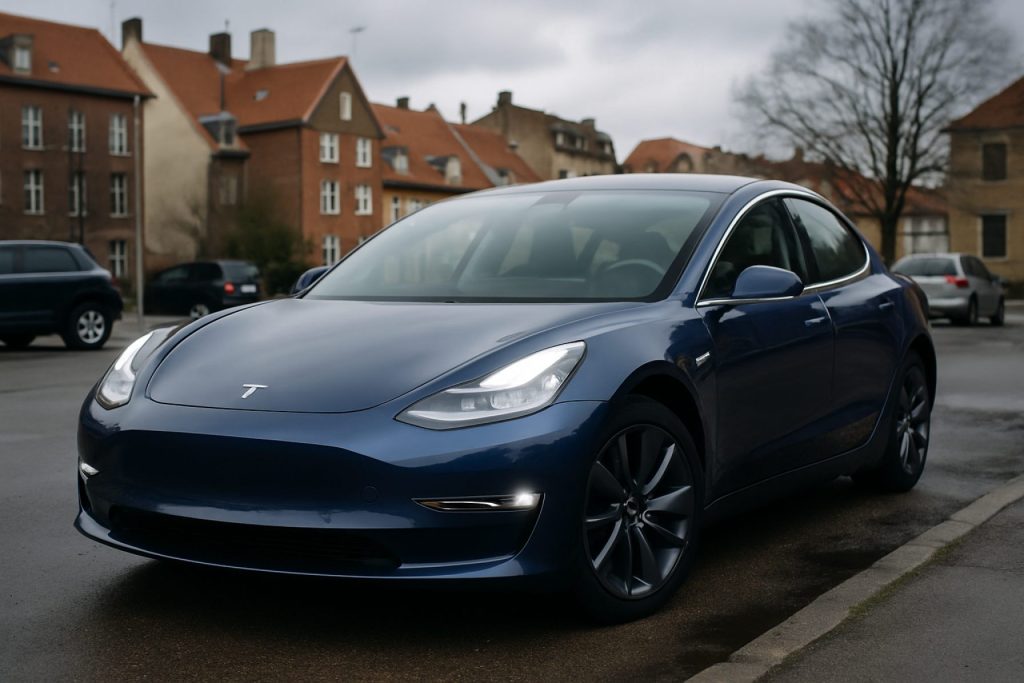
- Tesla’s European electric vehicle sales dropped nearly 50% last month, even as overall EV sales in the region surged by 28%.
- Public protests and political backlash against Elon Musk have damaged the Tesla brand’s image in Europe.
- First-quarter profits fell by 71%, exposing Tesla’s growing financial challenges as revenue trails expectations.
- Affordable new EV models, especially from China’s MG, have attracted price-conscious European consumers, contributing to Tesla’s declining market share.
- Factory shutdowns to upgrade the Model Y and ongoing US-EU trade tensions have further limited Tesla’s competitiveness.
- Success in the European electric car market now depends on innovation, adaptability, and regaining consumer trust amid changing preferences and economic pressures.
Tesla once sparked an electric revolution across Europe’s gleaming autobahns and bustling boulevards. Last month, that spark dimmed drastically as sales of the iconic American EV plunged by nearly 50%, dropping to just over 7,200 vehicles. Meanwhile, rivals zipped past: the continent as a whole saw a sparkling 28% surge in electric car sales, lighting up the future of transportation even as Tesla hit the brakes.
The Shift Beneath the Surface
Step into a European Tesla dealership now, and you might sense the tension humming beneath the chrome. Across dozens of cities, angry crowds have gathered, their placards and voices raised not just against the company, but against its founder, Elon Musk. Amid a wave of political fury over Musk’s association with U.S. power brokers and his high-profile support for populist figures, the Tesla brand has become an unlikely lightning rod for protest. Investors, too, have watched as Tesla’s profits plummeted: first-quarter earnings revealed a staggering 71% drop in profit and revenues that limped behind analyst predictions.
But the deeper story isn’t only about protests and politics. Tesla’s showroom floor tells its tale: a collection of models once hailed as futuristic, but now showing their age as hungry rivals flood the market. Particularly MG, owned by China’s ambitious SAIC, has dazzled buyers with a fleet of affordable electric vehicles, racking up a jaw-dropping 54% sales jump in April. European consumers, battered by economic tumult, have proven hungry for value—an area where Tesla’s price point can no longer claim leadership.
Factory Woes and Shifting Tides
Production problems have made matters worse. This year, Tesla idled several factories to update the best-selling Model Y, choking supply at the very moment the competition surged. Meanwhile, political headwinds from across the Atlantic—amplified by ongoing trade disputes—have cast American carmakers in an uneasy light. Former President Donald Trump’s threats to slap tariffs on EU goods have rattled European sentiment, and for many, “Made in America” no longer carries the magnetic appeal it once did.
Europe’s overall car market hasn’t stood still. While sales of gas-guzzling vehicles shrank, battery-powered newcomers multiplied, with total EU car sales inching up 1.3% year-over-year—a modest but critical sign of resilience in choppy economic waters. Yet, Tesla’s total sales for the first third of 2024 have tumbled by almost 40%, a far cry from its dominance just a handful of quarters ago.
The Road Ahead
As purveyors of innovation, Tesla and its dynamic CEO have long set the pace in the electric race. Now, however, the finish line looks uncertain. With political entanglements clouding the brand’s image, fresher and cheaper models pouring in from China and elsewhere, and economic anxieties reshaping buyer habits, Tesla faces a rocky road in a market where, until today, it wrote the rules.
Success in Europe’s future won’t depend on what’s under the hood alone—it will demand resilience, reinvention, and a recharged relationship with a shifting audience. For those eager to track the pulse of global technology and business, the lesson is clear: even the brightest stars can flicker, and today’s disruptor may be tomorrow’s disrupted.
Discover more global trends in innovation and business at nytimes.com and bbc.com.
Europe’s Electric Car Boom: Why Tesla’s Spark is Fading (And What You Need to Know Before You Buy in 2024)
The European Electric Vehicle (EV) Landscape: Key Insights
As Tesla’s European sales slump 50% and competitors like MG soar, it’s more clear than ever: the continent’s EV revolution is entering a new era. Here’s what industry experts, market data, and real-world experiences reveal—beyond the headlines.
—
Unexplored Facts & Context You Need to Know
1. Tesla’s Product Lineup Is Aging Faster Than Its Rivals
– Stale Models: The Tesla Model 3 and Model Y, while still tech-forward, have not seen the major design overhauls or updated interiors that European buyers increasingly expect (source: bbc.com).
– Competitor Upgrades: Leading brands like Volkswagen, Hyundai, and newcomers like BYD launch refreshed models almost annually, offering superior infotainment, advanced driver aids, and more design choices.
2. Price and Value Wars: Tesla Struggles to Compete
– Affordability Crisis: European economic pressures (inflation, high interest rates) have reset buyer expectations for maximum value. Competing EVs like the MG4 and BYD Atto 3 undercut Tesla by €5,000–€10,000 per comparable spec in many EU markets.
– Reduced Subsidies: Major markets like Germany (Tesla’s largest EU market) recently cut EV purchase incentives, amplifying buyers’ price-sensitivity.
3. Charging Network & Compatibility
– Tesla Supercharger Expansion: Tesla’s proprietary Supercharger network, once a major selling point, is now being opened to non-Tesla EVs—some say diluting its competitive edge. Meanwhile, public fast-charging infrastructure (Ionity, Allego) is expanding rapidly, eroding Tesla’s historical advantage ([source](https://www.bbc.com)).
– How To: Check Network Access Before Buying
1. Identify your nearest rapid charging options.
2. Review compatibility (not all European CCS chargers are equal).
3. Compare charging prices (Tesla’s Superchargers can be pricier for non-Tesla owners).
4. EU-China Tariffs & Geopolitical Risks
– Tariff Effect: The European Commission is actively exploring tariffs on Chinese EV imports. If imposed, this could narrow the price gap between Tesla and Chinese models (like MG/BYD), impacting future affordability and choice ([source](https://www.nytimes.com)).
– Risk to Resale: Political instability, especially involving the U.S. and China, can affect resale values and after-sales support.
5. Brand Image & Consumer Sentiment
– Elon Musk Factor: Surveys indicate that Musk’s growing political activism and controversial statements increasingly influence brand perception, particularly among young, urban buyers—the core Tesla demographic in Europe.
– Real-World Use Case: Anecdotal evidence from EV forums highlights buyers avoiding Tesla purely for political/personality reasons, regardless of price or technology ([source](https://www.nytimes.com)).
6. Sustainability & Supply Chain
– Battery Traceability: European regulators have tightened rules on battery sourcing and recycling. Brands with transparent, ethical mineral sourcing are gaining ground—Tesla faces scrutiny over cobalt sourcing, while VW and Hyundai trumpet “green supply chains.”
– Factory Emissions: Tesla’s Berlin Gigafactory faces local protests over water use and forest destruction, impacting its PR and relationships with “green” buyers.
—
Reviews, Comparisons & Industry Trends
Market Forecasts
– Chinese Brands on the Rise: Analysts (JATO Dynamics) predict that Chinese EVs will reach 20% market share in Europe by 2025 if tariffs remain low.
– Tesla’s Share Shrinking: Tesla’s European market share dropped from 18% of EV sales in Q1 2023 to approx. 10% in Q1 2024.
Features, Specs, & Pricing at a Glance
| Model | Typical Range (WLTP) | 0-100 km/h | Starting Price (DE) | Key Feature |
|———————|———————|————–|———————|————————-|
| Tesla Model 3 RWD | 513 km | 6.1 s | €42,990 | Tesla Autopilot |
| MG4 EV | 450 km | 7.7 s | €29,990 | Advanced driver assists |
| VW ID.3 | 426 km | 7.3 s | €39,995 | Customizable styling |
| BYD Dolphin | 427 km | 7.0 s | €29,990 | Heat pump as standard |
(Prices as of May 2024, subject to change)
Pros & Cons Overview
Tesla Pros:
– Industry-leading software/updates
– Reliable resale value (for now)
– Best-in-class real-world charging speed
Tesla Cons:
– Higher starting price
– Outdated cabin design versus rivals
– Brand image volatility
– Service delays in parts of Europe
—
Security & Sustainability
– Software Security: Tesla routinely pushes remote security updates; other automakers are only starting to match this agility.
– Sustainability: Tesla claims leading lifecycle emissions but faces criticism over lack of full battery traceability. European brands (VW, Renault) now provide battery passport transparency.
—
Most Pressing Reader Questions—Answered
Q: Will Tesla lower prices further in Europe?
A: Analysts say it’s possible, but steep EU tariffs on Chinese batteries/parts and increased manufacturing costs in Germany make major cuts unlikely without margin erosion ([source](https://www.nytimes.com)).
Q: Is now a good time to buy a Tesla in Europe, or should I wait?
A: If resale value, brand cachet, and software matter most, consider buying now—especially if tax subsidies are still active in your country. However, buyers wanting cutting-edge cabin tech, cheaper models, or political neutrality may want to wait for Model 3 “refresh” or check rivals like MG, Hyundai, or VW.
Q: Which EV brands are best for new buyers prioritizing value?
A: MG (backed by SAIC), BYD, and Kia/Hyundai currently offer the most competitive price-to-performance ratio in the compact and mid-size segments.
Q: How do trade disputes affect my future EV’s value?
A: Political tariffs could affect both the price and serviceability of Chinese/US-made vehicles. Buying vehicles with established EU manufacturing (VW ID-series, Renault) reduces this risk.
—
Actionable Recommendations & Quick Tips
1. Compare Total Ownership Costs: Factor in insurance, charging, maintenance, and potential loss of resale value—not just sticker price.
2. Test Multiple Brands: New EVs from MG, BYD, or Hyundai can now be test-driven across Europe; don’t rely on Tesla name recognition alone.
3. Monitor Tariff News: Stay informed on EU-China EV trade disputes—tariffs may make certain cars costlier overnight.
4. Check Charging Ecosystem: If you rely on public fast-charging, check real-world charger reliability in your area via PlugShare or Chargemap before buying.
5. Stay Politically Aware: If brand neutrality matters for business or resale (leasing fleet, ride-sharing), consider how current events might affect perception.
—
Final Thoughts: The European EV Market Is a Buyer’s Game
As competition intensifies, new models appear monthly, and political winds shift, European EV shoppers hold the power. Prioritize research, compare tax impacts, scrutinize real-world reviews, and—if in doubt—play the waiting game for a deal or design that truly excites you.
For up-to-date business and tech news, explore nytimes.com and bbc.com. For EV reviews and guides, major industry sites such as MG and others are emerging as trusted resources.
Stay charged, and happy car shopping!



